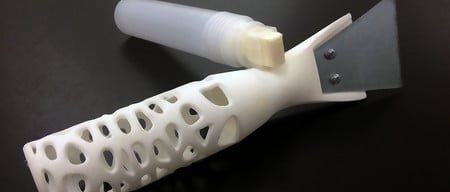A new startup offers something called “The Makeraser”. It’s a handheld tool that can smooth your unattractive visibly-layered 3D prints into beautiful smooth objects.
Current technology for smoothing ABS 3D prints involves suspiciously dangerous acetone vapor chambers or massively expensive commercial smoothing devices. That, or you spend many hours with sandpaper. The Makeraser hopes to change those options.
The Makeraser includes a small quantity of acetone in a reservoir that is applied through a felt tip, much like a marker pen. As the minute amounts of acetone touch your ABS print’s layers, they slightly dissolve and flow into the cracks, leaving a smoother surface. It may be a bit of work to smooth a complex or large object, but it’s likely a lot safer than having a jug of flammable acetone vapor being heated in your workshop.
But wait – the Makeraser does more than just smooth prints. It can also glue them together by applying acetone to two surfaces and pressing them together.
It also claims to solve the ABS warping problem. Apparently you can dissolve a small amount of ABS in the acetone reservoir, creating something they call “ABS Juice”. This substance is applied to your print bed, where the acetone quickly evaporates, leaving a well-stuck ABS layer on which your print can build. How then, we wondered, do you remove this super-stuck ABS from your print bed? Well, they do include a scraper accessory, but we suspect you could simply use the Makeraser again to dissolve and clean the print bed.
Theoretically you could put other chemicals in the reservoir to perform the same miracles on PLA and other printable materials.
It’s not clear how much the Makeraser costs as they have not yet launched their Kickstarter campaign. However, judging by the complexity of the device we cannot expect it to cost very much and therefore it could become an essential accessory for anyone printing ABS.
Via Makeraser



PLA? Ethanol, isopropyl-alcohol, isopropyl-alcohol/NaOH, dichloromethane, chloroform, Acetone…
isopropyl-alcohol/NaOH probably the best. Chloroform and dichloromethane probably the fastest… Can't use chloroform in a sponge like they do, but dichloromethane in the right sponge could work… probably just get a spray bottle and spray isopropyl alcohol/NaOH at it like you were painting outside…
I just don't get why it's on kickstarter, although it's a pretty cool idea it should be open-source. And please, somebody tell me which solvent should I use for my PLA prints, I don't want to experiment with MEK or THF because they can cause cancer… is there any safe way to vapor-finish PLA prints?